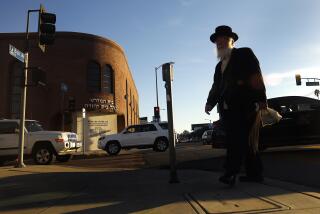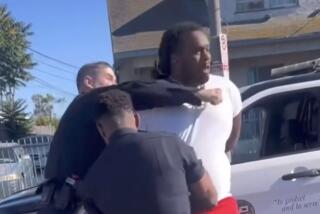Policing the ‘flash mobs’
- Share via
As crime in Los Angeles has dropped from the frightening levels of the 1990s to the astonishingly low rates of the last decade, pressure from residents and leaders to spend more money on law enforcement has turned into pressure to instead spend less, especially when so many other city services have been cut to accommodate shrinking budgets. But a well-trained police department with enough officers and expertise to respond rapidly to trouble isn’t simply a previous era’s priority. It is a perpetual need.
Tuesday night’s rampage in Hollywood, which may have been incited and organized through social media, is a reminder that police need sufficient resources to keep pace with technologies and social movements that can undermine public safety, and to respond in force to more than a single spot within the city at any given time.
Police speculated that a group of teenagers communicating through Twitter targeted the entertainment and tourist district for an evening of lawlessness in part because they knew a large number of officers would be deployed elsewhere — in the Crenshaw district, where on previous nights peaceful protests against the acquittal in Florida of George Zimmerman in the killing of Trayvon Martin were interrupted by violence. As many as 40 or 50 teenagers converged on Hollywood, where they knocked down pedestrians and in some cases took their cellphones, watches and other items. No serious injuries were reported, but the episode was not merely an irritating romp by teenagers with too much time on their hands. There were robberies and assaults.
Community policing requires more than officers knowing what is happening, on a day-to-day basis, on the streets they patrol. It also requires keeping in touch with those communities in cyberspace, to the extent that it can be done without crossing the line that separates patrolling and snooping. It requires knowing when “flash mobs” are forming. It requires as well being sufficiently involved in neighborhoods to be able to distinguish between peaceful expressions of anger — like most of the protests of the Zimmerman verdict — and acts of violence.
The Los Angeles Police Department has, to its credit, moved away from decades of confrontation-oriented policing to a more community-oriented approach, and that may have helped keep Tuesday’s events from getting even further out of hand. Or, perhaps, with better planning and deeper involvement in the communities it serves, the department could have prevented things from going as far as they did. Either way, Los Angeles deserves a full report on what went right and what went wrong, because if the LAPD expects the public to respond with resources, it must also expect scrutiny of its actions and deployment decisions.
More to Read
A cure for the common opinion
Get thought-provoking perspectives with our weekly newsletter.
You may occasionally receive promotional content from the Los Angeles Times.






